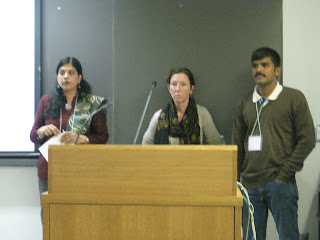Tamil Studies Conference, University of Toronto, May 11-13, 2012
 |
Presenters (l-r) Gita Pai, Zoe Headley, and S. Ponnarasu
respond to audience questions. |
Finding time in her busy schedule, Brenda was able to make it to a couple of Friday afternoon sessions of the 2012 Tamil conference in Toronto. She heard several very interesting speakers who shared a panel that focused on Royal Lineages, History, and Heritage in the Kongu area of Tamilnadu (nearby Madurai was also included). This is exactly the area covered by
The Legend of Ponnivala, and so the remarks made by the three speakers (S. Ponnarasu, Zoe Headley, and Gita Pai) were of great interest. The conversation and discussion that followed centered around the importance the people of this area give to a variety of strong mythical themes they feel tie them to the past. Of course this is exactly the kind of material
The Legend of Ponnivala weaves around its heroes. After the presentations, several commentators pointed out the way in which images about heritage and culture often become embedded stories. Politicized tales and very grand epithets are often used in this area to glorify the heritage and local roots of certain well-known families and their lineages. All in all, these traditions make for very colourful story telling in Kongunadu!
 |
| Prof. Noboru Karashima |
As a wrap up to the academic meetings of the day, the distinguished Professor Noboru Karashima gave a talk in the main assembly hall. His very scholarly and very interesting address was about “The Past as Known From Tamil Inscriptions.” Professor Karashima took a very detailed and highly statistical approach to the content of some 28,000 inscriptions ranging in time from the 3rd century BC to the 19th century AD. Particularly striking was the social detail relating to curses detailed in these stone and copper plate records. The consequences said to befall anyone who might wish to subvert a royal decree of a land grant, a gift of gold or the guarantee of various temple services were very severe indeed Traitors were declared as cursed to die young, to have barren wives, to be lower in status than a dog or a pig, to be cast out of the village where they lived, to have their women violated by those of very low status, to have their noses cut off, and more. It is interesting that many specifics
linked to these same themes are found embedded in the Ponnivala
legend too! There, several characters and communities undergo a
similar loss of face, or of respect, honour, and status as a
consequence of what could be called similar “social
misbehaviours”; situations where someone or some group breaks
accepted community norms.
Karasihma was also able to detect the loss of social power among both Vellalars and Brahmins from roughly the 13th century onward. From this point in time onward he was able to point to inscriptional traces that indicated the gradual rise in influence for various additional social groups.
These were ambitious and vocal communities who slowly began to insist
on their own status and rights. The groups Karashima particularly mentioned were the
idangai and
valangai (left hand and right hand groups, about whom Dr. Beck has written extensively). Karashima also suggested that several
of these groups probably originated, at least in part, from the
rising influence of various hill tribes. He also spoke of various merchant groups who began to hire ex-soldiers as guards (the Ainuruvar, Kaikolar and Vaniya Nagaram merchant guilds). Karashima linked this rise in additional social power clusters to a more general breakdown in the power of various great monarchs who had once held the area together. One could term Karashima’s paper a “tour de force.” It provided a fitting end to the scholarly day, and was of great interest to Brenda personally, since the hill tribes of the Kongu region play a vital role in bringing the heroes of the Ponnivala story to their knees toward the end of this legend (her favourite epic tale!).


No comments:
Post a Comment